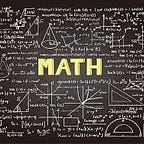Mathematics
The Basel Problem: 1 + 1/2² + 1/3² + …… = π²/6 — Two Simplest Proofs
Here, we are going to prove the Basel problem with two of the very simplest methods.
Definition and History:
The Basel problem is a problem in mathematical analysis with relevance to number theory, concerning an infinite sum of inverse squares. It was first proposed by Italian mathematician Peitro Mengoli in 1644. Peitro is highly regarded for his work in many infinite series, including the proof of the divergence of the Harmonic series, developing important results which later formed the basis for Newton and Leibniz. In his course of studying different infinite series, he was unable to find the sum of the below-mentioned infinite series.
This series is popularly known as the Basel problem in the memory of Bernoulli brothers and Leonhard Euler who were born in Basel. According to history of mathematics, the first world class mathematicians to work on the Basel Problem were the Swiss brothers Jacob Bernoulli (1654–1705) and Johann Bernoulli (1667–1748). Over the years of trying to solve the series, they gained no success. Leibniz, too, worked on this problem but got no solution. In 1721, Daniel Bernoulli (Johann’s son) found the value to be 8/5 and he wrote the letter to Goldbach. After that, Goldbach replied to his letter and claimed that the value is definitely between 1.64 and 1.66.
The difficulty in solving this series was that it converges very slowly, making it hard for mathematicians then to figure out the accurate solution.
It was in 1735 that Leonhard Euler proposed a complete solution to this problem stating that the sum is π²/6. As many great minds struggled with this problem, this brought Euler a lot of immediate fame among the mathematicians. Euler then published a more rigorous proof in 1741 and then went to publish a third proof in 1755. His proofs then inspired Weierstrass and Riemann to develop analysis and the zeta function defined as,
This led to the discovery of Reimann hypothesis, which still remains one of the most significant unsolved problem in mathematics.
Now, let’s get back to our two proofs of the Basel problem. One of the proof includes the Euler proof itself.
Proof 1 (Euler’s Proof):
For the proof, let’s write sin x as an infinite product of linear factors.
Also, writing the Maclaurin Series for sin x:
Comparing the coefficients of x³ from the above mentioned equations,
Q.E.D.
Proof 2:
Writing sin x as an infinite product of linear factors,
Differentiating with respect to x,
Substituting a = -ix or a² = -x²,
Using Euler’s formula,
Substituting this to the previous equation,
When taking x = 0, the LHS becomes the Basel problem, but the RHS turns out to be (∞ + 0/0) form, which is indeterminate. Using L’Hospital’s rule,
Q.E.D.
Important point to remember!
Euler’s proof was brilliant, but also not strictly speaking complete! He used manipulations which couldn’t be justified with the mathematics developed at that time. It would take 100 years before the gaps in Euler’s proof were completely filled. It was the brilliant analyst Karl Weierstrass, who developed the underlying theories that would eventually validate Euler’s argument.
There are other various methods of solving the Basel problem. It can be proved using Fourier Series, Cauchy’s proof, Weil’s conjecture or Tamagawa numbers, and many more that are not covered in this article. Euler’s solution to the Basel problem had a profound impact on the development of mathematics. The Basel Problem has established a deep connection between number theory, complex analysis, and algebraic geometry. The solution to Basel problem has many dimensions. It is useful in cryptography algorithm used in internet to transmit secret information like credit card numbers.
References:
· Carnegie Melon University — The Basel Problem Numerous Proofs
· The Basel Problem — Wikipedia
· The Basel Problem — 3Blue1Brown (YouTube)
· TU, 2014 — Daya Ram Paudyal — A Short Note on Basel Problem
Thank you for taking the time to read this article. Hope you enjoyed it. Feedbacks are highly appreciated!
